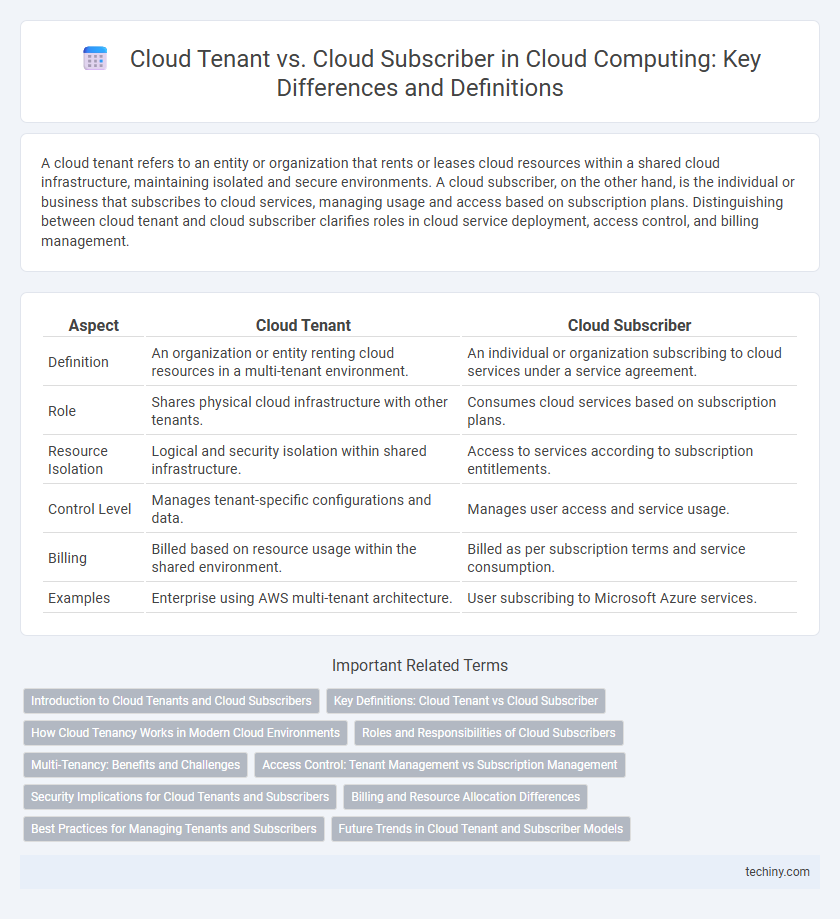A cloud tenant refers to an entity or organization that rents or leases cloud resources within a shared cloud infrastructure, maintaining isolated and secure environments. A cloud subscriber, on the other hand, is the individual or business that subscribes to cloud services, managing usage and access based on subscription plans. Distinguishing between cloud tenant and cloud subscriber clarifies roles in cloud service deployment, access control, and billing management.
Table of Comparison
| Aspect | Cloud Tenant | Cloud Subscriber |
|---|---|---|
| Definition | An organization or entity renting cloud resources in a multi-tenant environment. | An individual or organization subscribing to cloud services under a service agreement. |
| Role | Shares physical cloud infrastructure with other tenants. | Consumes cloud services based on subscription plans. |
| Resource Isolation | Logical and security isolation within shared infrastructure. | Access to services according to subscription entitlements. |
| Control Level | Manages tenant-specific configurations and data. | Manages user access and service usage. |
| Billing | Billed based on resource usage within the shared environment. | Billed as per subscription terms and service consumption. |
| Examples | Enterprise using AWS multi-tenant architecture. | User subscribing to Microsoft Azure services. |
Introduction to Cloud Tenants and Cloud Subscribers
Cloud tenants are organizations or users who lease resources from a cloud provider, sharing the underlying infrastructure with other tenants while maintaining isolated environments for data and applications. Cloud subscribers are individuals or entities who have entered into a subscription agreement to consume specific cloud services, often with predefined usage limits and billing models. Understanding the distinction between tenants and subscribers is crucial for designing multi-tenant architectures and managing access control in cloud ecosystems.
Key Definitions: Cloud Tenant vs Cloud Subscriber
A Cloud Tenant refers to an individual or organization that uses a shared cloud environment with allocated resources, maintaining data isolation and privacy within a multi-tenant architecture. A Cloud Subscriber is the entity that registers for cloud services and holds the subscription contract with the cloud provider, managing billing and access rights. Understanding the distinction is crucial for grasping roles in cloud service models, where tenants consume resources and subscribers control service agreements.
How Cloud Tenancy Works in Modern Cloud Environments
Cloud tenancy in modern cloud environments enables multiple tenants to share the same physical infrastructure while maintaining data isolation and security through virtualization and containerization technologies. Each cloud tenant operates independently with dedicated resources, applications, and storage, ensuring a tailored computing experience within a multi-tenant architecture. Cloud subscribers access cloud services through digital contracts or subscriptions, but the cloud tenant represents the organizational boundary that manages user access, resource allocation, and compliance within the shared cloud infrastructure.
Roles and Responsibilities of Cloud Subscribers
Cloud subscribers are entities or individuals who contract for cloud services but do not own the underlying infrastructure, focusing primarily on consumption, configuration, and management of resources within the constraints set by the cloud provider. They are responsible for managing user access, ensuring data security compliance, and optimizing workload performance within the tenant environment. Cloud subscribers maintain operational control over their applications and data while relying on the cloud tenant to handle infrastructure maintenance, scalability, and availability.
Multi-Tenancy: Benefits and Challenges
Cloud tenants share a single cloud infrastructure while maintaining data isolation, enabling cost efficiency and resource optimization through multi-tenancy. Cloud subscribers access and consume cloud services, often without direct control over infrastructure, emphasizing ease of use and scalability. Multi-tenancy presents challenges such as data security, resource contention, and compliance management, requiring robust access controls and tenant isolation mechanisms to ensure service reliability and privacy.
Access Control: Tenant Management vs Subscription Management
Cloud tenants control resource allocation and access permissions within a shared cloud environment, enabling fine-grained tenant management for multi-user collaboration and security boundaries. Cloud subscribers focus on subscription management, involving billing, service usage limits, and overall access to cloud service plans. Access control in tenant management emphasizes user roles and policies within an organization's cloud space, while subscription management centers on managing entitlements and service-level agreements tied to the subscriber account.
Security Implications for Cloud Tenants and Subscribers
Cloud tenants and cloud subscribers face distinct security implications due to their roles in cloud environments; tenants often control data and application deployment, requiring robust identity and access management to prevent unauthorized access. Subscribers rely on service providers' security measures, making it critical to evaluate provider compliance with standards like ISO 27001 and SOC 2 for data protection and incident response. Understanding shared responsibility models helps both tenants and subscribers implement complementary security controls to mitigate risks such as data breaches and insider threats.
Billing and Resource Allocation Differences
A Cloud Tenant typically represents an organization or a user group that shares cloud resources within a multi-tenant environment, with billing often managed at the tenant level based on aggregated resource consumption. A Cloud Subscriber, on the other hand, is an individual or entity subscribing to cloud services, with billing directly tied to their specific subscription plan and usage patterns. Resource allocation for tenants involves shared infrastructure optimized for collective performance, while subscribers receive dedicated resources aligned with their subscription terms and service level agreements (SLAs).
Best Practices for Managing Tenants and Subscribers
Effective management of cloud tenants and subscribers requires clear role definitions and access controls to ensure security and resource optimization. Implement identity and access management (IAM) policies that enforce least privilege principles and regular auditing for compliance. Utilize tenant isolation techniques and subscriber segmentation to prevent data leakage and improve performance monitoring across multi-tenant environments.
Future Trends in Cloud Tenant and Subscriber Models
Cloud tenant models are evolving towards enhanced multi-tenancy architectures, enabling greater resource isolation and customized service levels within shared cloud environments. Cloud subscriber models increasingly emphasize automated subscription management, integrating AI-driven usage analytics to optimize cost-efficiency and service scalability. Emerging trends also highlight the convergence of tenant and subscriber roles through unified platforms, fostering seamless access control and personalized cloud experiences.
Cloud Tenant vs Cloud Subscriber Infographic

 techiny.com
techiny.com